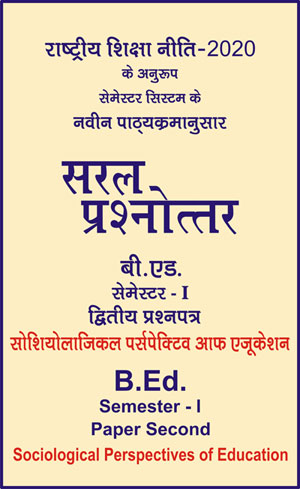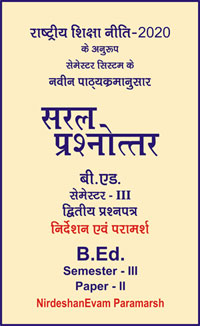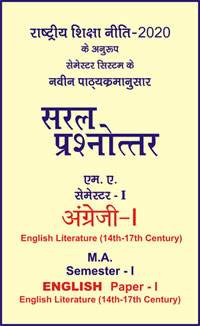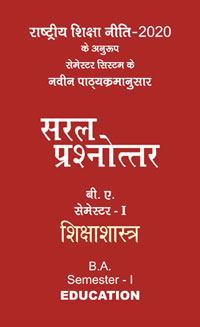|
बी एड - एम एड >> बी.एड. सेमेस्टर-1 प्रश्नपत्र-II - सोशियोलाजिकल पर्सपेक्टिव आफ एजूकेशन बी.एड. सेमेस्टर-1 प्रश्नपत्र-II - सोशियोलाजिकल पर्सपेक्टिव आफ एजूकेशनसरल प्रश्नोत्तर समूह
|
|
|||||||
बी.एड. सेमेस्टर-1 प्रश्नपत्र-II - सोशियोलाजिकल पर्सपेक्टिव आफ एजूकेशन (अंग्रेजी भाषा मे)
Question- Write an essay of marginalization.
Ans.
Marginalization
The term ‘marginalization’ portrays the activities or tendencies of human societies, where individuals who are considered unwanted, or without perceivable functions are rejected, i.e., marginalized. The population who are marginalized are outside the current arrangement of protection and integration. This confines their chances and means for survival.
The Encyclopaedia of Public Health characterizes minimization as, to be underestimated is to be set in the edges, and subsequently avoided from the benefit and power found at the middle. The Encyclopaedia of Public Health defines marginalization as, to be marginalised is to be placed in the margins, and thus excluded from the privilege and power found at the centre.
Meaning of Deprived/ Marginalized Groups
The idea of Deprived/Marginalized Group is commonly used to analyse financial, political, and social spheres, where disadvantaged individuals battle to access resources and full participation in public activity. As such, underestimated individuals may be socially, financially, politically and legally disregarded, excluded, or neglected and, therefore vulnerable. Marginality is disparaging, for monetary prosperity, for human dignity, and for physical security.
Nature of Deprived/ Marginalized Groups
Marginalization is, to put in a place of minor significance, impact, or power, marginalized is a multidimensional, multi-causal, historical phenomenon. To consign or restrict to a lower or oredge, of social standing. There are no general laws to comprehend the complex nature of Marginalization. Marginalization can be because of class, in connection of social, cultural, economic and political conditions, as well as ideological systems, social awareness, and human actions. Marginalized Groups fluctuate in various settings. The religious, ecological system, patriarchy, political economy of a country, and the general social framework affect the marginalization of specific groups or an individual.
Marginalization differs from culture to culture. This can be found it in connection to older individuals living in various nations and societies. The solid and supportive family framework in certain societies frequently gives better regard and care to elders than the public aided system accessible in others. Marginalized groups happen all the while at the micro and macro levels. Denied/Marginalized groups happens at various levels, individual, group, community, and global. Discrimination across different social institutions, such as family, schools and neighbourhood, at work places, or places of worship. Globalization too has increased the gap between rich and poor nations.
Types of Marginalization : In the past section, we examined the meaning and nature of marginalization. In this section, we will study the types of marginalization. To be marginalized is to be separated from power and resources that enable self-determination in economic, political and social settings.
(i) Social Marginalization : Marginality is both ascribed and acquired in a social setting. The experience of marginality emerges in various ways. For certain individuals, those impaired from birth, or those born to minor groupings for instance, lower caste groups in India, this marginality is ordinarily long lasting and decides their lived experiences. For other people, marginality is obtained by later disablement or by changes in the social and economic systems. As worldwide capitalism is bringing an ever increasing number of individuals into its framework, more communities are dispossessed of lands, livelihoods, or systems of social support.
Individuals who are socially marginalized are generally denied of social opportunities. They may become stigmatized and are regularly at the end of negative attitude of public. Their chances to make social commitments might be constrained, and they may grow low self-esteem and confidence. Social policies may mean that they have relatively limited access to valued social resources such as education and health services, housing, income, leisure activities, and work. Different people will react differently to marginalization depending on the personal and social resources available to them. Another problem is that people born in a marginalized community lack the required social and cultural capital to participate in mainstream development processes. Their social networks are weak and vulnerable. Lack of social capital deprives an individual of access to resources, such as, economic, educational and cultural and other support systems. This creates social isolation and limits their participation in the development process.
(ii) Economic Marginalization : Economic marginalization as a procedure identifies with monetary structures, specifically, to the structure of business sectors and their combination. To the degree in the business sectors that a few people or groups‘ take part in are separated from the others all in all, these people can be said to be marginalized from whatever is left of the economy. Division and rejection may, in any case, have non-monetary and non-money related origins, for instance in discrimination by gender, caste, or ethnicity. Here, integration takes on a broader meaning. People who are experiencing marginalization are likely to have tenuous involvement in the economy. The sources of their income will vary. These experiences affect men and women differently and vary with age. Poverty and economic marginalization have both immediate and aberrant effects on individuals’ wellbeing and prosperity.
(iii) Political Marginalization : Political marginalization does not enable the group to take an participate democratically in decision making and, hence, they lose their right to every benefit, and henceforth, they lose their entitlement to each social, economic and political advantage. Political empowerment standout amongst the most imperative instruments for getting to other social and financial benefits. In each society, absence of political empowerment influences extensive areas of individuals, women, ethnic minorities, migrants, disabled persons, elderly, etc. So far as gender is concerned, we find that participation by women is limited over the globe. It is men who hold power and lead legislative issues the world over. This is valid at all dimensions of intensity in governmental issues, regardless of whether it is party leadership, elected offices, appointed offices, or at policy making levels. This kind of marginalization is also felt by ethnic minorities, migrants, disabled persons, elderly, etc.
Education of The Deprived/ Marginalized Groups
It is broadly recognized that education has a critical job to accomplish a more noteworthy level of social equity. The educational institutions are required to prepare children to the best of their capacity for verifying an important spot in the public sphere and in this manner cultivating a procedure of building up a egalitarian society. Notwithstanding, countless are still excluded from the educational system and subsequently can’t participate meaningfully in the economic, social, political and cultural life of their communities.”
Most vulnerable Deprived/Marginalized Groups : Some of the most vulnerable marginalized groups in almost every society are :
(i) Women
(ii) People with Disabilities
(iii) Elderly
(iv) Ethnic minority
(v) Caste Groups
(vi) Tribes.
Problems Related to Education for Deprived/Marginalized Groups
The challenge of poverty associated with disability : India is among one of those countries having highest percentage of worlds out of school children. It is found that significant number of children with disability are living below the poverty line. Disability and poverty form vicious circle in which disability leads poverty and vice versa. Poverty and disability together results into simultaneous deprivation.
The challenge of modifying deeply held attitudes : Attitudes of the non-disabled are ended up being a noteworthy obstruction in the social joining of people with disabilities. “The more extreme and obvious the deformation is, the more prominent is the dread of virus, henceforth the dispositions of abhorrence and isolation towards the disabled.” Such frames of mind strengthened by religious foundations may militate against any endeavours to incorporate students with disabilities into ordinary schools. For instance, Hindus trust that inability is an outcome of offenses performed in the past life (regularly alluded to as the principle of Karma). Any endeavours to improve the life of an individual with an inability might be considered an insubordination of the wills of Allah or as impedance with an individual’s karma.
Dissemination and public education : People, including guardians and school staff, are generally unaware of the full aim of the ongoing legislations passed by Indian Parliament. A large number of school staff are additionally not mindful of subsidy available to incorporate students with disabilities in schools. There is some proof that those teachers who are learned about government strategies and laws concerning incorporated training will in general have inspirational frames of mind toward actualizing such projects. There is additionally proof when parents are proficient and steady of coordinated training; they will in general positively affect school work force. Thus, unless individuals, particularly parents of childrens with disability and school work force, are made aware about the different arrangements cherished in the Act, the Central and State governments’ pledge to giving integrated education will be futile.
The challenge of providing adequate levels of training to key stakeholders : Most of school work force in India are not prepared to structure and actualize educational programs for students with disabilities in standard schools. Most teacher training programs in India don’t have a unit on Disability Studies. The educational institutions, which do cover a few parts of a special education in their teacher training programs, neglect to prepare teachers sufficiently to work in integrated settings.
Inadequate resources : Most of schools in India are ineffectively planned and few are prepared to meet the one of a kind needs of students with disabilities. The absence of disability friendly transportation and accessible buildings are considered by some to be far more noteworthy issues than social prejudice and negative frames of mind. Both the Central and State governments should give expanded assets to this part of education to guarantee fruitful execution of coordinated practices in schools.
Mainstreaming the Marginalized Groups
Mainstreaming is the process which depicts integrating the students with special needs into regular school classes. Government always strive to incorporate these students into the current thoughts and activities of prevailing group. Efforts have been made for inclusive education to these deprived sections of society. There are various factors such as economic, social and educational causes that hamper the education of children coming from lower strata of society. @
|
|||||

 i
i 










